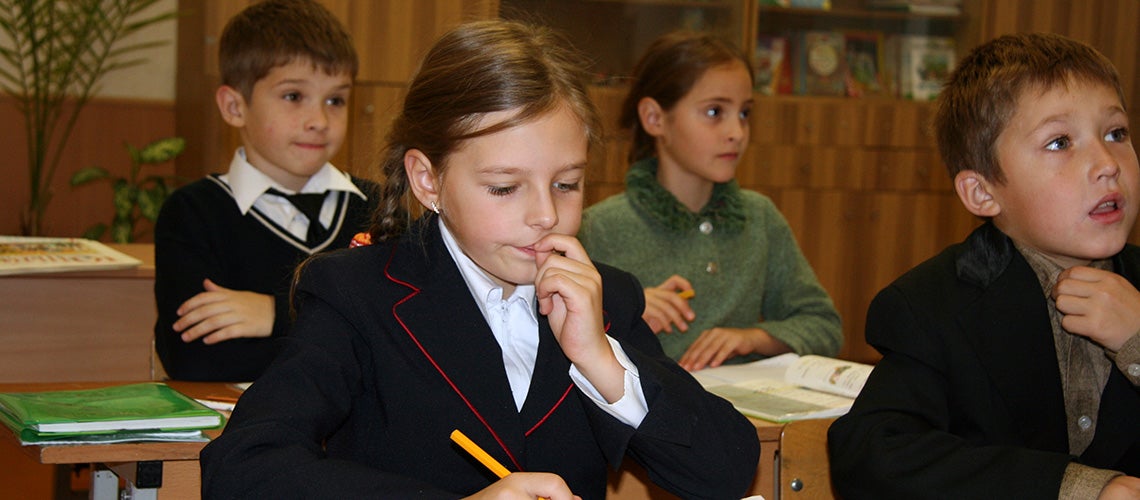 Students in a classroom from Belarus. | ©I rina Oleinik/ World Bank
Students in a classroom from Belarus. | ©I rina Oleinik/ World Bank
The impacts of the COVID-19 pandemic will be felt for a long time. The health, social and economic effects on society have been monumental. In 2022, over 70 million additional people globally were living in poverty on account of the pandemic.
Other, longer-term effects on well-being have not yet fully materialized. Learning losses associated with school closures and ineffective remote learning have dealt a massive blow to human capital accumulation for people under the age of 25.
In our new paper, we attempt to quantify potential long-run welfare effects of worldwide school closures by simulating their impact on inter-generational mobility. By mapping the estimates of losses in learning-adjusted years of schooling (LAYS) from the latest World Bank learning losses simulations onto estimates of inter-generational mobility in education, we find that, in the absence of remedial measures, learning losses are likely to significantly reduce intergenerational mobility in a wide range of countries.
We focus on intergenerational mobility because it represents a universal human aspiration of parents for a better life for their children, and because it is closely associated with inequalities of opportunity and income in a society.
Following an earlier report, Fair Progress, we focus on two different measures of mobility: absolute mobility, or the share of children who have more years of education than their parents, and relative mobility, measured by 1 – COR (where COR is the correlation coefficient between parents’ and children’s years of education), with a higher correlation indicating greater persistence or lower relative mobility.
We find significant negative impacts of school closures on absolute mobility, when learning losses vary across countries but are assumed to be uniform across children within each country. The share of children with more years of education than their parents falls by an average of 9 percentage points for high-income economies and 4 percentage points for developing countries (figure 1).
Among developing countries, the decline in absolute mobility is largest in upper-middle income countries, at 8 percentage points. The losses are large enough in many cases to reverse past improvements in absolute mobility in lower middle-income countries during the 1960s and 1970s.
These impacts are consistent with a massive disruption in learning – globally, students are estimated to have lost more than a year of schooling, adjusted for learning. The impact on absolute mobility tends to be larger in higher income countries, because students lose more learning for an equivalent number of days of school closures, where the quality of education is higher.
Assuming uniform losses within countries leaves relative mobility measures unchanged. This assumption is however unrealistic since children from disadvantaged socioeconomic backgrounds are less likely to have access to remote learning.
To account for this, we take advantage of World Bank-supported high frequency phone surveys for 30 countries. These tell us whether children were learning during school closures, and if so, whether through in-person interactions with teachers or media platforms (such as mobile apps, TV or radio).
As we cannot observe the effectiveness of remote learning, we make assumptions about the relative effectiveness of different modes of learning — that learning through media platforms is likely to be:
- more effective than a complete lack of remote learning, and
- less effective than in-person interactions or completing assignments provided by the teacher; and that
- all modes of remote learning are less effective than pre-pandemic learning.
We choose several scenarios that reflect these assumptions to explore the sensitivity of our results to such choices. We then extrapolate from these estimates to the full set of over 150 countries in our sample, assuming similar patterns for countries in the same income group.
Figure 1: Evolution of absolute mobility by birth cohort, with uniform COVID learning losses

Notes: COVID-impacts on absolute mobility assume uniform within-country learning losses. Distributionally-sensitive impacts on absolute mobility are similar in magnitude.
Due to the effect of unequal learning losses within countries, relative mobility is estimated to decline by 2-3 percent in developing countries and 1-4 percent in high-income economies, depending on how effective we believe remote learning to be (figure 2). In upper-middle income countries, where the impacts of learning losses are largest in magnitude, relative mobility could decline by 3-7 percent under different scenarios.
Figure 2: Evolution of relative mobility (1-COR), with COVID impacts under different learning effectiveness scenarios

Notes: The graph plots the impacts under a range of assumptions regarding the relative effectiveness of pandemic learning.
These are meaningful impacts, given the slow-moving nature of the relative mobility measure over time. For developing countries overall, the change is equivalent to about 40 percent of the decline in relative mobility between the 1970s and 1980s birth cohorts, and up to 80 percent under more optimistic assumptions about the effectiveness of remote learning.
Thus, the COVID-19 related school closures could significantly worsen the secular pre-pandemic decline in relative mobility in developing countries. More optimistic assumptions about the effectiveness of remote learning lead to greater impacts on relative mobility, because children from disadvantaged backgrounds were less likely to have remote learning of any kind than those from more privileged backgrounds.
The positive news is that the effects estimated here on long-term outcomes are not necessarily inevitable or irreversible. Loss of learning, however distributed, need not become a permanent loss in educational attainment, if the right remedial measures are taken in time.
Yet, the window of opportunity is limited, and the more delayed these interventions are, the more costly and less effective they are likely to be to recover the learning losses. We must not minimize or lose sight of the urgency of addressing such longer-term risks, if society is to truly meet parents’ aspirations for a better life for their children.





Join the Conversation